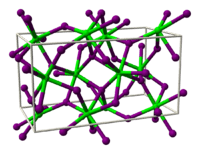Strontium iodide
 | |
| Names | |
|---|---|
| IUPAC name
Strontium iodide | |
| Identifiers | |
| 10476-86-5 (anhydrous) | |
| 3D model (Jmol) | Interactive image |
| ECHA InfoCard | 100.030.871 |
| EC Number | 233-972-1 |
| PubChem | 25304 |
| RTECS number | WK9275000 |
| UNII | F6V5HOR0O5 |
| |
| |
| Properties | |
| SrI2 (anhydrous) SrI2·6H2O (hexahydrate) | |
| Molar mass | 341.43 g/mol (anhydrous) |
| Appearance | Colorless to white crystalline plates |
| Density | 4.55 g/cm3 (anhydrous)[1] 4.40 g/cm3 (hexahydrate)[1] |
| Melting point | 507 to 645 °C (945 to 1,193 °F; 780 to 918 K)[2] |
| Boiling point | 1,773 °C (3,223 °F; 2,046 K) (decomposes) |
| 177.0 g/100 mL (20 °C)[3] | |
| Solubility in ethanol | 3.1 g/100 ml (4 °C) [3] |
| Structure | |
| Orthorhombic, oP24 | |
| Pbca, No. 61 | |
| Hazards | |
| Main hazards | Corrosive |
| R-phrases | R14 R34 |
| S-phrases | S22 S26 S27 S36/37/39S45 [4] |
| NFPA 704 | |
| Related compounds | |
| Other anions |
strontium fluoride strontium chloride strontium bromide |
| Other cations |
beryllium iodide magnesium iodide calcium iodide barium iodide |
| Except where otherwise noted, data are given for materials in their standard state (at 25 °C [77 °F], 100 kPa). | |
| | |
| Infobox references | |
Strontium iodide (SrI2) is a salt of strontium and iodine. It is an ionic, water-soluble, and deliquescent compound that can be used in medicine as a substitute for potassium iodide .[5] It is also used as a scintillation gamma radiation detector, typically doped with europium, due to its optical clarity, relatively high density, high effective atomic number (Z=48), and high scintillation light yield.[6]
Reactions
Strontium iodide can be prepared by reacting strontium carbonate with hydroiodic acid:
Strontium iodide yellows when exposed to air. At high temperatures (when in the presence of air) strontium iodide completely decomposes to form strontium oxide and free iodine.[7]
References
- 1 2 Yaws, C.L. (2008). Thermophysical properties of chemicals and hydrocarbons. William Andrew. ISBN 978-0-8155-1596-8.
- ↑ Turner, Jr., Francis M., ed. (1920), The Condensed Chemical Dictionary, New York: The Chemical Catalog Company, p. 449, retrieved 2007-12-10
- 1 2
177 g/100 mL (20 °C) Seidell, Atherton (1907), Solubilities of Inorganic and Organic Substances, New York: D. Van Nostrand, p. 318, retrieved 2007-12-10 - ↑ 400696 Strontium iodide anhydrous, beads, −10 mesh, 99.99+ %
- ↑ Shoemaker, John V. (1908), A Practical Treatise on Materia Medica and Therapeutics (7th ed.), Philadelphia: F. A. Davis, p. 854, retrieved 2007-12-10
- ↑ Prettyman, Thomas; Burger, Arnold; Yamashita, Naoyuki; Lambert, James; Stassun, Keivan; Raymond, Carol (2015). "Ultra-bright scintillators for planetary gamma-ray spectroscopy". SPIE Newsroom. doi:10.1117/2.1201510.006162. ISSN 1818-2259.
- ↑ Bartley, Elias H. (1898), Text-book of Medical and Pharmaceutical Chemistry (5th ed.), Philadelphia: P. Blakiston, pp. 267–268, retrieved 2007-12-10
This article is issued from Wikipedia - version of the 9/26/2016. The text is available under the Creative Commons Attribution/Share Alike but additional terms may apply for the media files.
